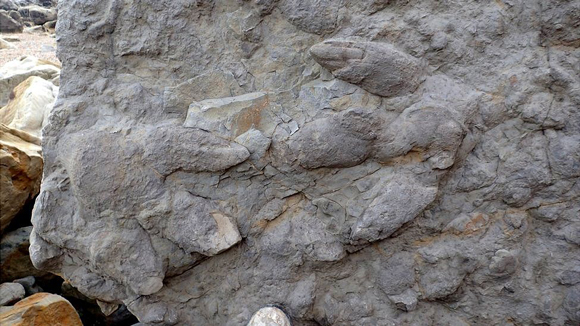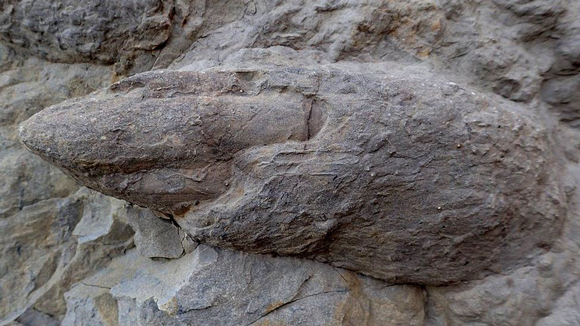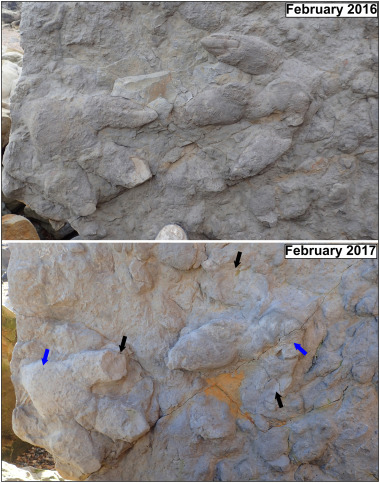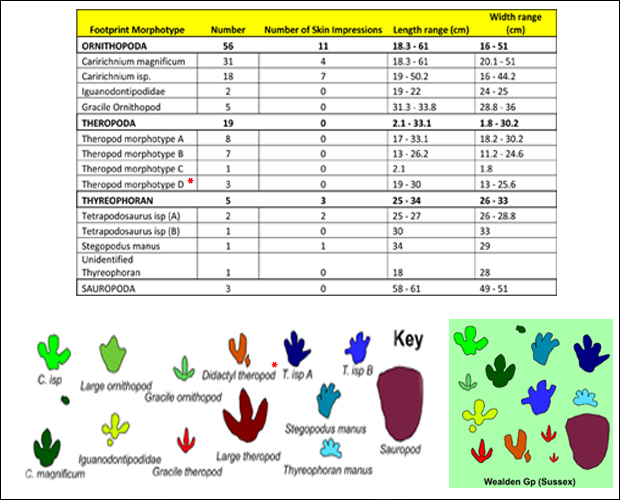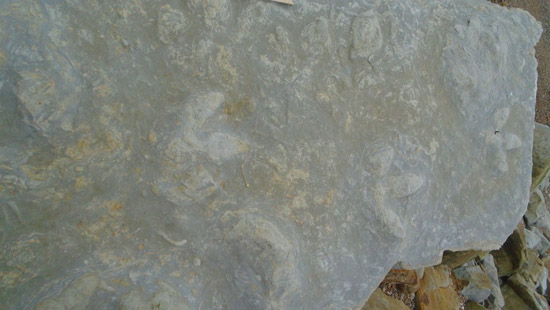Dozens of Dinosaur Footprints Exposed at Hastings
Dinosaur Footprints Exposed by Cliff Erosion
The seaside town of Hastings in East Sussex is steeped in history. It is synonymous with the battle that began the Norman conquest back in 1066 but scientists have been aware for many years that the cliffs to the east of the town contain evidence of much older inhabitants – dinosaurs. Researchers from the Department of Earth Sciences at Cambridge University have published a paper this week documenting dozens of Early Cretaceous dinosaur tracks and footprints that represent at least seven different kinds of dinosaur.
Two Iguanodontian Prints from the Lee Ness Sandstone (Ashdown Formation) Exposed at Hastings
Picture credit: Neil Davies/University of Cambridge
A Rich and Diverse Dinosaur Fauna
The footprints and trackways were identified and mapped by a team of researchers from Cambridge University between 2014 and 2018, following periods of extensive coastal erosion along the cliffs to the east of Hastings. The footprints range in size from 2 cm wide to over 60 cm across. These prints and tracks record a rich and diverse dinosaur fauna from the Lower Cretaceous – Lee Ness Sandstones (Ashdown Formation), which date from approximately 140 million years ago (Berriasian faunal stage of the Cretaceous).
The exact age of the Lee Ness Sandstone strata is unknown, however, the Ashdown Formation is estimated to be around 145-133 million years old, based on relative dating of ostracod fossils.
The researchers, writing in the academic journal ” Palaeogeography, Palaeoclimatology, Palaeoecology”, report on more than 85 exceptionally well-preserved dinosaur footprints, comprising prints from at least seven different types of dinosaur (ichnogenera). They document the trace fossils eroding out of cliffs and their work records the greatest diversity of dinosaurs in a single location in Cretaceous-aged rocks found in the UK. In particular, a variety of armoured dinosaurs (Thyreophora) are represented.
One of the Many Different Types of Armoured Dinosaur Print Found
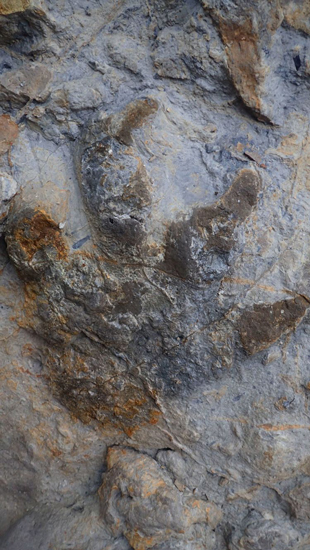
Picture credit: Neil Davies/University of Cambridge
Details of Skin, Scales and Claws are Visible
The trace fossils are preserved in remarkable detail. Impressions of skin, scales and even toe claw impressions have been preserved.
A Close View of an Iguanodontian Print Showing a Distinct Claw Impression
Picture credit: Neil Davies/University of Cambridge
An Iguanodontian Footprint with Preserved Skin Impressions
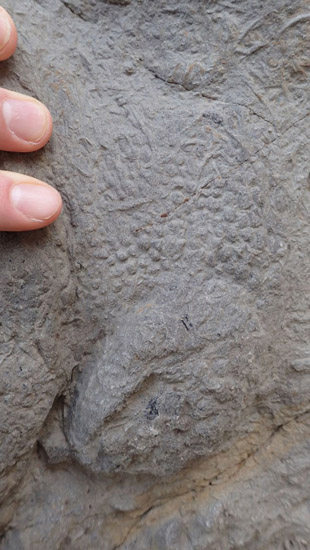
Picture credit: Neil Davies/University of Cambridge
The best preserved prints come from large blocks of stone that are mapped and photographed after recently falling from the cliff. The tracks are quickly eroded with prolonged exposure to the elements and from damage caused by further rock falls. When dealing with a rapidly eroding cliff, it is essential that any fresh rock falls are examined and any fossils contained within the blocks are mapped and measured.
Two Photographs (February 2017 and February 2016) Showing the Extent of the Trace Fossil Erosion
Picture credit: Neil Davies/University of Cambridge
Wealden Group Trace Fossils
The Ashdown Formation is part of the Wealden Group of rock formations, the most important sequence of dinosaur fossil bearing strata in England. Numerous fossilised footprints are associated with the Wealden Group and the first report of tracks was made in 1846 by the Reverend Tagart, who described a series of three-toed prints, which he thought had been made by giant birds. Never before has such a diverse footprint assemblage been mapped and documented in the British Isles.
A Table Showing the Different Types of Dinosaur Footprint (Morphotypes) Mapped at the Location
Table credit: Palaeogeography, Palaeoclimatology, Palaeoecology with additional notation from Everything Dinosaur
One of the authors of the scientific paper, Anthony Shillito, a PhD student in Cambridge’s Department of Earth Sciences commented:
“Whole body fossils of dinosaurs are incredibly rare. Usually you only get small pieces, which don’t tell you a lot about how that dinosaur may have lived. A collection of footprints like this helps you fill in some of the gaps and infer things about which dinosaurs were living in the same place at the same time.”
Different Kinds of Theropod Dinosaurs
The footprints along with the various plant fossils and invertebrate trace fossils (burrows), are helping the scientists to put together a picture of life in this part of the world in the Early Cretaceous. Dinosaurs dominated the biota, with several different types of meat-eating dinosaur (theropods) identified, including a potential dromaeosaurid-like dinosaur, as two-toed prints (didactyl) have been found.
Different Types of Theropod Track Have Been Found
Picture credit: Neil Davies/University of Cambridge
Footprints of Dinosaurs
The picture above shows four different types of theropod footprint identified at the Hastings site. Picture (A) shows a large tridactyl (three-toed) cast with a long digit III and a faint heel impression. The footprint in (B), is also large but the toes are narrower and elongated, maintaining a consistent width for their whole length. The cast has no heel pad impression. The theropod morphotype (C), represents a much smaller animal with digit III being much longer than digits II and IV. Intriguingly, the researchers have also logged potential two-toed prints (D), this suggests that this floodplain, braided environment might have been home to dromaeosaurid-like dinosaurs.
PhD student Shillito added,
“You can get some idea about which dinosaurs made them from the shape of the footprints, comparing them with what we know about dinosaur feet from other fossils lets you identify the important similarities. When you also look at footprints from other locations you can start to piece together which species were the key players.”
Although, the majority of the footprints have been ascribed to ornithopods, and several are referred to as iguanodontian, none of these prints were made by a member of the Iguanodon genus. Iguanodon (I. bernissartensis), lived many millions of years after these prints were formed. There have been many different types of iguanodont described, it is possible that the larger prints were made by an animal such as Barilium dawsoni. The slightly smaller prints could have been created by the iguanodontid Hypselospinus (H. fittoni).
The Three-toed Tracks of a Small Ornithopod Dinosaur
Picture Credit: Neil Davies/University of Cambridge
Dinosaurs Helping to Shape the Environment
Anthony Shillito is focusing on the role played by dinosaurs in terms of shaping their environment, how dinosaurs behave as zoogeomorphic agents. Large animals today, such as elephants and hippos can alter their habitats as they interact with their environment. Hippos for example, can create river channels and divert the course of water flow. Dinosaurs very probably did the same, with larger dinosaurs having a bigger impact than smaller dinosaurs.
The student commented:
“Given the sheer size of many dinosaurs, it’s highly likely that they affected rivers in a similar way, but it’s difficult to find a ‘smoking gun’, since most footprints would have just washed away. However, we do see some smaller-scale evidence of their impact; in some of the deeper footprints you can see thickets of plants that were growing. We also found evidence of footprints along the banks of river channels, so it’s possible that dinosaurs played a role in creating those channels.”
Evidence of Sauropods?
Footprint evidence indicating the largest dinosaurs of all, the presence of sauropods is virtually absent from the site. Three poorly preserved trace fossils have been tentatively ascribed to the Sauropoda, although they are very indistinct and could represent under traces representing the tracks of other ichnogenera.
It is very likely that there are many more dinosaur footprints hidden within the eroding sandstone cliffs of East Sussex, but the construction of sea defences in the area to slow or prevent the process of coastal erosion may mean that they remain locked away within the rocks.
The scientific paper: “Dinosaur-landscape Interactions at a Diverse Early Cretaceous Tracksite (Lee Ness Sandstone, Ashdown Formation, southern England)” by Anthony P. Shillito and Neil S. Davies published in Palaeogeography, Palaeoclimatology, Palaeoecology.
The Everything Dinosaur website: Everything Dinosaur.


